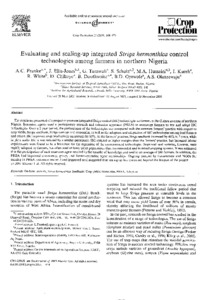| dc.contributor.author | Franke, A. |
| dc.contributor.author | Ellis-Jones, J. |
| dc.contributor.author | Tarawali, G. |
| dc.contributor.author | Schulz, S. |
| dc.contributor.author | Hussaini, M.A. |
| dc.contributor.author | Kureh, I. |
| dc.contributor.author | White, R. |
| dc.contributor.author | Douthwaite, Boru |
| dc.contributor.author | Oyewole, B. |
| dc.contributor.author | Olanrewaju, A.S. |
| dc.date.accessioned | 2019-12-04T11:18:08Z |
| dc.date.available | 2019-12-04T11:18:08Z |
| dc.date.issued | 2006 |
| dc.identifier.citation | Franke, A., Ellis-Jones, J., Tarawali, G., Schulz, S., Hussaini, M.A., Kureh, I., ... & Olanrewaju, A. (2006). Evaluating and scaling-up integrated Striga hermonthica control technologies among farmers in northern Nigeria. Crop Protection, 25(8), 868-878. |
| dc.identifier.issn | 0261-2194 |
| dc.identifier.uri | https://hdl.handle.net/20.500.12478/3071 |
| dc.description.abstract | The results are presented of a project to promote integrated Striga control (ISC) technologies to farmers in the Guinea savanna of northern Nigeria. Extension agents used a participatory research and extension approach (PREA) to encourage farmers to test and adopt ISC technologies. Over a 2-year period, the performance of the technologies was compared with the common farmers’ practice with respect to crop yields, Striga seedbank, Striga damage and economics, as well as the adoption and adaptation of ISC technologies among lead farmers and others. ISC improved crop productivity on average by 88%. In the farmers’ practice, Striga seedbank increased by 46% in 2 years, while in plots under ISC it was reduced by a similar percentage. ISC resulted in higher margins than the farmers’ practice, but increased labour requirements were found to be a limitation for the expansion of the recommended technologies. Improved seed varieties, however, were rapidly adopted by farmers, but often used at lower plant populations than recommended and in mixed cropping systems. It was estimated that the participation of each extension agent resulted in the transfer of knowledge and seed to an average of 240 farmers. In addition, the PREA had improved community, group, and farmer–extension agent relationships. Ongoing demand by Government and NGOs for training in PREA, extension material and improved seed suggested that scaling-up has continued beyond the lifespan of the project. |
| dc.description.sponsorship | Department for International Development, United Kingdom |
| dc.language.iso | en |
| dc.subject | On-Farm Research |
| dc.subject | Striga Hermonthica |
| dc.subject | Seedbank |
| dc.subject | Crop Yields |
| dc.subject | Economics |
| dc.subject | Prea |
| dc.subject | Adoption |
| dc.title | Evaluating and scalingup integrated Striga hermonthica control technologies among farmers in northern Nigeria |
| dc.type | Journal Article |
| dc.description.version | Peer Review |
| cg.contributor.affiliation | International Institute of Tropical Agriculture |
| cg.contributor.affiliation | Silsoe Research Institute |
| cg.contributor.affiliation | Ahmadu Bello University |
| cg.coverage.region | Africa |
| cg.coverage.region | Acp |
| cg.coverage.region | West Africa |
| cg.coverage.region | Europe |
| cg.coverage.country | Nigeria |
| cg.coverage.country | United Kingdom |
| cg.isijournal | ISI Journal |
| cg.authorship.types | CGIAR and developing country institute |
| cg.iitasubject | Plant Diseases |
| cg.iitasubject | Farm Management |
| cg.iitasubject | Markets |
| cg.iitasubject | Livelihoods |
| cg.iitasubject | Food Security |
| cg.iitasubject | Crop Husbandry |
| cg.iitasubject | Research Method |
| cg.iitasubject | Handling, Transport, Storage And Protection Of Agricultural Products |
| cg.iitasubject | Plant Production |
| cg.iitasubject | Impact Assessment |
| cg.iitasubject | Agribusiness |
| cg.iitasubject | Diseases Control |
| cg.accessibilitystatus | Limited Access |
| local.dspaceid | 94537 |
| cg.identifier.doi | https://dx.doi.org/10.1016/j.cropro.2005.11.014 |

